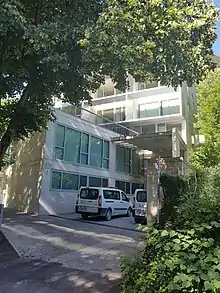| Established | 2006[1] |
|---|---|
| Research type | Low-background physics |
| Location | Canfranc, Aragón (Spain) |
Operating agency | University of Zaragoza |
| Website | www.lsc-canfranc.es |


The Canfranc Underground Laboratory (Spanish: Laboratorio Subterráneo de Canfranc or LSC) is an underground scientific facility located in the former railway tunnel of Somport under Monte Tobazo (Pyrenees) in Canfranc. The laboratory, 780 m deep and protected from cosmic radiation,[2] is mainly devoted to study rarely occurring natural phenomena such as the interactions of neutrinos of cosmic origin or dark matter with atomic nuclei.[3][1][4]
Access to the tunnel containing the laboratory is at the Estación Internacional de Canfranc, a former international railway station in the village of Canfranc.[5][4][6]
Experiments
As of 2023, the following experiments are ongoing in Canfranc:[7]
- ANAIS, WIMP dark matter search experiment
- DArT, experiment to measure the radioactive activation of argon
- TREX-DM, WIMP dark matter search experiment
- NEXT, neutrinoless double beta decay experiment
- CROSS, Cryogenic Rare-event Observatory with Surface Sensitivity, searching for neutrinoless double beta decay
- SuperKGd (also known as SUPERK-GD or under similar names), experiment for mapping of background noise signal for the Super-Kamiokande neutrino telescope in Japan. There is a plan to operate the Super-Kamiokande detector with Gadolinium salt dissolved into the water-mass of the detector. This operation would introduce unknown backgrounds in the neutrino-detection process of Super-Kamiokande, and SuperK-Gd is mapping those backgrounds.
- BabyIAXO, preparing the ground for the full infrastructure of the IAXO (International Axion Observatory) which is a new generation axion helioscope and its main goal is to detect axions (or other similar particles) potentially emitted by the Sun’s core in large quantities
- GOLLUM, underground biology experiment
As of 2023, the following experiments were described as proposals:[8]
- Multicellular structure formation in response to low level background radiation, a biology experiment
- Microorganisms with enhanced DNA damage repair abilities, a biology experiment
- Interaction between host and pathogens under low-radiation background, a biology experiment
- THE MODERN-E PROJECT, a study of wireless transmission of geotechnical data through clay rocks. Through its works, it aims to achieve a wireless monitoring system capable of operating with the measurement instrumentation commonly used for monitoring the main geotechnical parameters that are relevant for the operation of the future nuclear waste repository
- CADEX, the Canfranc Axion Detection Experiment
- Luria-Delbrück 2.0, studying cosmic radiation to evaluate its possible role in the mutation rate of bacteria
- Bacteria in heavy water, a biology experiment
- NEXT-HD, the fourth phase of the NEXT program
- NaI-CGF, this proposal aims to build and commission an underground facility to grow ultra-high radiopurity NaI(Tl) scintillators
- HENSA, High Efficiency Neutron-Spectrometry Array
- ARQ-Qubits, aims at developing a new technology to mitigate the effects of radiation on qubits
- DAMIC, Dark Matter in CCDs, a dark matter detection experiment
- LU, Low-level γ spectroscopy with High Purity Germanium (HPGe) detectors, a radiopurity experimemt
- CUNA, an underground nuclear astrophysics facility
As of 2023, the following experiments have completed their activities in Canfranc:[9]
- ArDM, WIMP dark matter search experiment
- ETSEC, preliminary study for the Einstein Telescope project
- BiPo, radio-purity of materials experiment
- ROSEBUD, dark matter experiment
- LAGUNA, neutrino observatory study (just a study, no real experiment hardware built and no measurements of any sort took place)
- GOLLUM, underground biology experiment
References
- 1 2 "Canfranc Underground Laboratory is ready to go". 212.71.251.65/aspera. Archived from the original on 22 March 2014. Retrieved 22 March 2014.
- ↑ "Cosmic-ray muon flux at Canfranc Underground Laboratory". Eur. Phys. J. C 79 (8) 721 (2019). doi:10.1140/epjc/s10052-019-7239-9.
- ↑ "The Canfranc Underground Laboratory" (PDF). lsm.in2p3.fr. Archived from the original (PDF) on 1 July 2014. Retrieved 22 March 2014.
- 1 2 Iliana Mier (July 15, 2019). "The secret lab where Nazis hid gold". BBC Reel. BBC Travel. Retrieved August 9, 2019.
- ↑ Obscura, Atlas. "The Abandoned Nazi Train Station Turned Underground Astroparticle Laboratory". slate.com. Retrieved 22 March 2014.
- ↑ Povinec, Pavel (28 July 2011). Analysis of Environmental Radionuclides. ISBN 9780080553375. Retrieved 22 March 2014.
- ↑ "Current Experiments Canfranc Underground Laboratory". LSC Canfranc.
- ↑ "Proposals - LSC Canfranc". LSC Canfranc.
- ↑ "Past Experiments - LSC Canfranc". LSC Canfranc.
External links
- Home
- The Canfranc Underground Astroparticle Laboratory: Experimental Program Status, Results & Prospects Archived 2021-09-20 at the Wayback Machine presentation, Angel Morales, University of Zaragoza
- Estación internacional de Canfranc. Ayuntamiento de Canfranc
42°44′58″N 0°30′59″W / 42.749374°N 0.516330°W